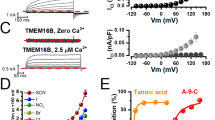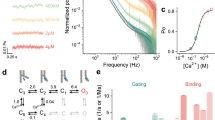Abstract
Calcium channels contribute to important cellular functions such as impulse conduction, rhythmic activity, muscle contraction, and secretion1 and are a major target for modulation by neurohormones and drugs2,3. Despite their importance, Ca channels are much less well understood than Na and K channels because of several problems reviewed by Hagiwara and Byerly1. First, few preparations allow good control of electrical potential and ionic composition on both sides of the membrane, yet display strong Ca currents. Second, current carried by Ca channels is often obscured by ion movements through other membrane pathways. Third, outward current flow through Ca channels, carried by Ca2+ or any other ion, has been difficult to demonstrate. This is unfortunate because measurements of the potential at which current reverses (Erev) have been crucial in understanding ion permeation and selectivity in other ionic channels (see ref. 4). In molluscan neurones, attempts at recording outward current through the Ca channel have not succeeded, largely because of overlap by nonspecific outward current5–7. In multicellular cardiac muscle preparations, strong depolarizations produce a decaying outward current that Renter and Scholz attributed to K efflux through the Ca channel8. Their interpretation is controversial, however, since the evidence leaves open other explanations for the outward current—for example, Na efflux via Na–Ca exchange9, or K efflux through K-selective channels. To overcome these problems, we studied Ca channels in single isolated heart muscle cells10–12 using a suction pipette method13. We were able to record robust Ca currents with minimal interference from other time-dependent currents while controlling potential and ion composition on both sides of the membrane. Here we present experimental evidence for a genuine reversal of ionic current through Ca channels due to outward movement of K+ ions, in support of the hypothesis of Reuter and Scholz.
This is a preview of subscription content, access via your institution
Access options
Subscribe to this journal
Receive 51 print issues and online access
$199.00 per year
only $3.90 per issue
Buy this article
- Purchase on Springer Link
- Instant access to full article PDF
Prices may be subject to local taxes which are calculated during checkout
Similar content being viewed by others
References
Hagiwara, S. & Byerly, L. A. Rev. Neurosci. 4, 69–125 (1981).
Tsien, R. W. & Siegelbaum, S. in Physiology of Membrane Disorders (eds Andreoli, T. E., Hoffman, J. F. & Fanestil, D. D.) 517–538 (Plenum, New York 1978).
Reuter, H. A. Rev. Physiol. 41, 413–424 (1979).
Hille, B. in Membranes: A Series of Advances Vol. 3 (ed. Eisenman, G.) 255–323 (Dekker, New York, 1975).
Kostyuk, P. G. & Krishtal, O. A. J. Physiol., Lond. 270, 545–568 (1977).
Akaike, N., Lee, K. S. & Brown, A. M. J. gen. Physiol. 71, 509–531 (1978).
Hagiwara, S. in Molluscan Nerve Cells: From Biophysics to Behavior (eds Koester, J. & Byrne, J. H.) 33–54 (Cold Spring Harbor Laboratory, New York, 1980).
Reuter, H. & Scholz, H. J. Physiol., Lond. 264, 17–47 (1977).
Mullins, L. Am. J. Physiol. 236, C103–C110 (1979).
Lee, K. S., Kao, R. L. & Brown, A. M. Circulation 60, 11–108 (1979).
Isenberg, G. & Klockner, U. Nature 284, 358–360 (1980).
Powell, T., Terrar, D. A. & Twist, V. W. J. Physiol., Lond. 319, 82–83P (1981).
Lee, K. S., Weeks, T. A., Kao, R. L., Akaike, N. & Brown, A. M. Nature 278, 268–271 (1979).
Siegelbaum, S. A. & Tsien, R. W. J. Physiol., Lond. 299, 485–506 (1980).
Meech, R. W. & Standen, N. B. J. Physiol., Lond. 249, 211–239 (1975).
Kenyon, J. L. & Gibbons, W. R. J. gen. Physiol. 73, 139–157 (1979).
Thompson, S. H. & Aldrich, R. W. in The Cell Surface and Neuronal Function (eds Cotman, C. W., Poste, G. & Nicolson, G. L.) 49–85 (North Holland, New York, 1980).
Lee, K. S., Lee, E. W. & Tsien, R. W. Biophys. J. 33, 143a (1981).
Hamill, O. P., Marty, A., Neher, E., Sakmann, B. & Sigworth, F. J. Pflügers Arch. ges. Physiol. 391, 85–100 (1981).
Horn, R. & Patlak, J. B. Proc. natn. Acad. Sci. U.S.A. 77, 6930–6934 (1980).
Hume, J. R. & Giles, W. J. gen. Physiol. (in the press).
Marban, E. & Tsien, R. W. J. Physiol., Lond. (in the press).
Eckert, R., Tillotson, D. & Brehm, P. Fedn Proc. 40 (in the press).
Marban, E. & Tsien, R. W. Biophys. J. 33, 143a (1981).
Author information
Authors and Affiliations
Rights and permissions
About this article
Cite this article
Lee, K., Tsein, R. Reversal of current through calcium channels in dialysed single heart cells. Nature 297, 498–501 (1982). https://doi.org/10.1038/297498a0
Received:
Accepted:
Issue Date:
DOI: https://doi.org/10.1038/297498a0
This article is cited by
-
Differential effects of organic calcium‐channel blockers on diastolic SR calcium‐handling in the frog heart
British Journal of Pharmacology (2002)
-
Calcium channel currents in isolated smooth muscle cells from the basilar artery of the guinea pig
Pfl�gers Archiv European Journal of Physiology (1991)
-
Cardiac-type excitation-contraction coupling in dysgenic skeletal muscle injected with cardiac dihydropyridine receptor cDNA
Nature (1990)
-
Marcroscopic and single-channel studies of two Ca2+ channel types in oocytes of the ascidianCiona intestinalis
The Journal of Membrane Biology (1990)
-
Neurotransmitter inhibition of neuronal calcium currents by changes in channel voltage dependence
Nature (1989)
Comments
By submitting a comment you agree to abide by our Terms and Community Guidelines. If you find something abusive or that does not comply with our terms or guidelines please flag it as inappropriate.



